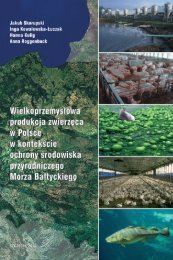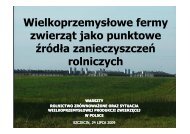best available technologies for manure treatment - Baltic Green Belt
best available technologies for manure treatment - Baltic Green Belt
best available technologies for manure treatment - Baltic Green Belt
You also want an ePaper? Increase the reach of your titles
YUMPU automatically turns print PDFs into web optimized ePapers that Google loves.
Best Available Technologies <strong>for</strong> <strong>manure</strong> <strong>treatment</strong> baltic sea 2020<br />
Best Available Technologies <strong>for</strong> <strong>manure</strong> <strong>treatment</strong> baltic sea 2020<br />
ANNEX E: TABLES WITH SHORT DESPRIPTION OF LIVESTOCK MANURE TREATMENT TECHNOLOGIES<br />
Best Available Techniques <strong>for</strong> <strong>manure</strong> <strong>treatment</strong> - <strong>for</strong> intensive rearing of pigs in <strong>Baltic</strong> Sea Region EU Member States Technical Report "Best Practice Manure Handling, Phase 2"<br />
Ref No. 24 Adding other chemical to <strong>manure</strong>, here under enzymes<br />
Brief description<br />
Description of the effect on leaching (positive or negative) of N<br />
and P<br />
Under the generic denomination of <strong>manure</strong> additives are a group of products made up of different<br />
compounds that interact with the <strong>manure</strong>, changing its characteristics and properties.<br />
These products are applied to the pig <strong>manure</strong> in the pits, and the following effects are described to<br />
different degrees in the label of every product:<br />
1. a reduction in the emission of several gaseous compounds (NH3 and H2S)<br />
2. a reduction of unpleasant odours<br />
3. a change in the physical properties of the <strong>manure</strong> to make easier its use<br />
4. an increase in the fertilising value of the <strong>manure</strong><br />
The effects on leaching in concerning N related with the additive<br />
effect on emission on ammonia and other N compounds. Less<br />
emission of ammonia emissions means that less N could return<br />
as atmospheric deposition and that more N is re-circulated in<br />
the agricultural production rather than ending in the<br />
environment.<br />
The effect on P leaching is associated with the use of additives<br />
in processes to separate the <strong>manure</strong> in fractions, allowing the<br />
fibre fraction with a high content of P to be exported to areas<br />
with a low livestock density.<br />
5. a stabilisation of pathogen micro-organisms.<br />
Usually, the items 2 and 3 are the main reasons <strong>for</strong> their use at a farm level. Below the techniques 1 – 5<br />
are detailed.<br />
1. Additives <strong>for</strong> reducing the emission of several gaseous compounds: The decrease in gaseous<br />
emissions achieved through its use (mainly NH<br />
3<br />
and H<br />
2<br />
S) is one of the most interesting yet controversial<br />
points. It has been well documented that up to 90 % of the N produced by the pigs is as urea. When the<br />
urease produced by faecal micro-organisms comes into contact with urea, the following reaction occurs:<br />
CO(NH<br />
2<br />
)2 + 3 H<br />
2<br />
O 2 NH<br />
4<br />
+ HCO<br />
3<br />
+ OH<br />
This reaction is highly influenced by temperature and pH, <strong>for</strong> example, under 10 °C or at a pH below 6.5<br />
the reaction stops.<br />
2. Additives <strong>for</strong> reducing unpleasant odours: Odour results from the mix of different compounds under<br />
anaerobic conditions. More than 200 substances involved have been identified, such as:<br />
volatile fatty acids<br />
alcohols (indol, skatole, p-cresol, etc)<br />
H<br />
2<br />
S and derivatives<br />
ammonia<br />
other N compounds (amines and mercaptans).<br />
There is a huge variation in the proportion and concentration of every substance depending on the type<br />
of farm, nutrition and nutritional management, and climatic conditions. This could explain why in many<br />
instances the effectiveness of these compounds against odours could not be proven under farm<br />
59<br />
Side 60<br />
59








